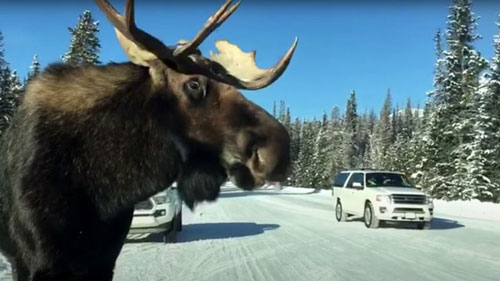Ottawa
Motorists in Florida occasionally need to keep an eye out for 12-foot, 463-pound alligators hanging out on the side of the road. Canadians have a different problem: moose that are addicted to licking road salt off of cars.
It sounds silly, like a winter-themed urban legend or some strange outgrowth of an overactive imagination, but it’s a real problem that some drivers deal with on a shockingly regular basis. It’s common enough that Canadian officials need to put up signs to remind motorists that road salt is not a normal part of a well-balanced moose diet.
“I hate to say it, but this road salt is kind of like crack [to moose],” explained Joe Urie, the owner of the Jasper Tour Company, in an interview with the CBC. Moose can lick the salt off of the tarmac, but they’ve learned that it’s just as delicious — and probably more concentrated — if it comes off of a car’s body panels, so they approach motorists. It’s a problem that’s becoming increasingly common as the moose population grows (it’s inversely proportional to the wolf population, which is declining), and as moose become more and more comfortable around humans.
Tourists are compounding the problem by travelling to the area specifically to give the Rocky Mountain car wash a shot; a moose licking a RAV4 is social media gold. Canadian officials have consequently taken measures to keep moose away from cars, and to keep people away from moose, according to Jasper-based publication Fitzhugh. Starting in 2020, motorists are no longer allowed to leave their car if they encounter wildlife in Jasper National Park. And, those who feed, entice, or disturb wildlife in the park risk receiving a C$25,000 fine (about $20,000 U.S.).
What happens if a moose simply can’t resist getting a fix of salt? According to Alberta Parks, motorists should try to scare off the moose by honking their horn, for example, but they should never attempt to push it away.—AP










